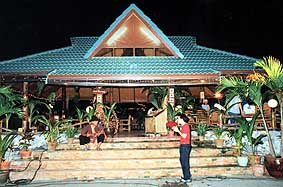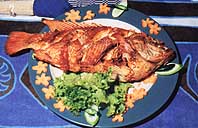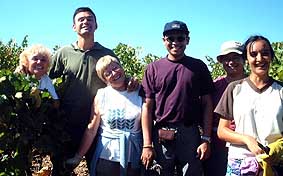






















|
Dining Out: Sala
Rim Taley - a real sleeper by the sea
by Miss Terry Diner
An acquaintance introduced me to Peter, the manager of
the Sala Rim Taley Restaurant in front of Natural Park Resort at Jomtien,
and the Dining Out Team followed up the proffered invitation.
 The restaurant is quite some distance down Jomtien
Beach Road, approximately 0.7 kilometres past the well known Nang Nual
Restaurant, but look for the Natural Park Resort sign. The restaurant is
housed in a large open sala adjoining the road, with the resort’s pool
behind it. There are also tables not under cover if you really want the
open air sea breezes, and on our night we chose a table closest to the
beach and it did indeed get the soft wind from the sea. The restaurant is quite some distance down Jomtien
Beach Road, approximately 0.7 kilometres past the well known Nang Nual
Restaurant, but look for the Natural Park Resort sign. The restaurant is
housed in a large open sala adjoining the road, with the resort’s pool
behind it. There are also tables not under cover if you really want the
open air sea breezes, and on our night we chose a table closest to the
beach and it did indeed get the soft wind from the sea.
The atmosphere is very Thai, with the wooden sala,
wooden chairs and large tables covered in Thai prints and woven bamboo and
traditional weave placemats and napkin holders. The cutlery is also the
traditional bronze Thai style. On the night we were there a TV crew was
also filming an episode of “Had Hansa” (Happy Beach - a very popular
Thai serial), so the staff were very busy.
The menu commences with appetizers priced between
40-100 baht and one of the first items to confuse slightly is that the
English translations for the various dishes are actually in “German
English” - Peter is German, while his Thai wife Kanya is the chef. This
sometimes will mean that the spelling of the words is unusual, but once
you get used to the phonetic handling of the English language there is no
problem.
There are 4 soups (B. 60-120) with the classics, tom
yum goong and tom kha gai and a maa-maa neua. Six salads are up next (B.
50-100), followed by 6 rice and noodle dishes, with various forms of kow
pad (fried rice) in evidence. Six Thai favourites are next (B. 70-90) with
gai pad khing (stir fried chicken with ginger) and a pad saparot gai
(chicken with pineapple) on offer.
 The next section has 6 curries (B. 70-90) including an
interesting beef and pumpkin in yellow curry as well as the more usual
gaeng keo waan. Seafood is next (B. 80-280) with sweet and sour or with
garlic and pepper being just two of the different ways. That section is
followed by Steak and Grills (B. 160-230) with 3 fish and 3 steak dishes
including pepper steak and steak mit knoblauch. There is also an
interesting B. 220 per person set menu with a starter of satays and spring
rolls, followed by a tom yum goong and then five different ‘mini’
courses, which change daily. It is also an “all you can eat” deal. The next section has 6 curries (B. 70-90) including an
interesting beef and pumpkin in yellow curry as well as the more usual
gaeng keo waan. Seafood is next (B. 80-280) with sweet and sour or with
garlic and pepper being just two of the different ways. That section is
followed by Steak and Grills (B. 160-230) with 3 fish and 3 steak dishes
including pepper steak and steak mit knoblauch. There is also an
interesting B. 220 per person set menu with a starter of satays and spring
rolls, followed by a tom yum goong and then five different ‘mini’
courses, which change daily. It is also an “all you can eat” deal.
There is no wine list per se, but Peter does have a
selection covering Spanish, German, French and Australian. The wine prices
range between B. 370-950. We chose a bottle of Bauer 1997 Riesling, but I
believe it was the last in stock, before you go asking for it! By the way,
the glasses were also good quality.
Madame had ordered the pla kapong thod gratiem prik
Thai (garlic and pepper) while I ordered the panang gai curry. While we
were waiting, cold towels came to the table, a nice touch. When the food
arrived, the first impression was the simply amazing presentation. The
rice surrounded by decorative vegetables and the fish a golden brown with
fried garlic sprinkled over it. My panang came in a large coconut complete
with special serving spoon.
Madame’s fish was cooked to perfection, with the skin
lightly crisped but the flesh still moist, and there was nothing left at
the end! The panang was authentic, packed with chicken and very
flavoursome and enjoyable.
Sala Rim Taley has a fabulous ambience, great food and
is inexpensive. It has only been going for a few months and most have not
heard of it. However, you have now. Try this Thai restaurant, you will not
be disappointed.
Sala Rim Taley, in front of Natural Park Resort, 412
Moo 12, Soi 17, Jomtien Beach Road, telephone 038 231 561-4 or 01 295
5030, email [email protected]
Nightmarch
Accident waiting to happen: I’ve
mentioned this before, but a recent letter to the Pattaya Mailbag prompts me
to raise the issue of speeding motorbikes in Soi’s 7 and 8 again. The
combination of copious quantities of booze and powerful, growling motorbikes
steered by testosterone-inflated morons hoping to impress the local bar
girls means that it will only be a matter of time before someone is either
killed or seriously injured in either Soi 7 or Soi 8.
Soi 7 is narrow at the best of times, with little room
for pedestrian traffic while Soi 8, although a little wider, is still not a
pedestrian-friendly street and is probably the more dangerous of the two.
Because it is impractical to ban traffic (ala Walking Street) at night, it
surely wouldn’t stretch the budget of City Hall to slap a few speed bumps
(or ‘traffic calming devices’ as they are euphemistically called in
politically correct countries) along Soi 8 and the bottom half of Soi 7.
An accident or two may still occur, but at least the
local governing bodies could argue that they had attempted to find a
reasonable answer to a potential problem.
Rebadged and reworked: The new Freestyle Fun Pub has
its official opening on Sunday December 9. Formerly the original site of
Tony’s Cool Spot and then lovingly and expensively turned into T.W. One,
the site, set back off Walking Street, has been repainted and remodelled and
will feature a few young ladies doing the chrome pole hug as well as a
karaoke room out the back overlooking Pattaya Bay. Nosh will still be
available on site.
Star light, star bright: If you happen to be
strolling down Walking Street and wander into Soi Diamond looking for a
friendly beer boozer, make your way into the alley that leads through to
Pratamnak Road and check out Star Light. The public house underwent a
remodelling a couple of months ago and since the installation of the
somewhat ubiquitous dartboard as well as the less common table football,
business seems to have picked up.
Back to Beer only: The Sexy ogling den (Walking
Street) has abandoned its 40 baht amber fluid and house liver wasters happy
hour between 7 p.m. and 9 p.m. with the only booze available at a lower
impost being a small glass of Chang draft at 49 baht.
Cupido and pool: The Bojangles beer boozer, the
biggest in the Cupido Bar Complex, located behind Soi Skaw Beach or opposite
the Diana Estate in Soi Buakhow (depending from which direction you’re
coming), has just installed two brand new pool tables. For regular customers
and those who happen to purchase more than one drink, games on the pool
table are free. For those who buy only one drink, games are charged out at
20 baht each.
This is apparently the policy of the majority of the
boozers in the Cupido Complex and seems pretty fair to me. If you’re going
to have one drink and play a half dozen or so games then 20 baht a throw is
not unreasonable. If, however, the girls know you’re a regular or you
happen to be drinking at a fair pace, then your games are free.
Haddock from a paddock: The Rosie O’Grady’s nosh
house and boozer (Soi 7) has been justifiably famous for its fish and chips
dinner ever since it first opened. Indeed, when it was known as the Last
Resort, the fish and chips meal was possibly its main claim to fame.
I’m happy to say nothing seems to have changed. I
recently got stuck into a plate of the fish and chips (good value at 165
baht) and found, as on past occasions, the brain food seemed to go on
forever. If the Biblical story of feeding a multitude with a handful of
loaves and fishes is to be believed, then Rosie O’Grady’s must have had
a franchise in Palestine about 2,000 years ago. Maybe Blustery Bill, Rosie
O’Grady’s loquacious mouthpiece, really is twice as old as Methuselah.
In brief: The G-Strings ogling den (Beach Road,
between Soi 7 and 8) has been renamed Worldwide. I haven’t had time to
find out yet whether it’s just a name change or it’s been sold and is
under new management.
Tahitian Queen ogling den (Beach Road) now opens at 1:00
p.m. with a happy hour until 2:00 p.m.
The connections of Hot and Cold 2/Full Moon Night ogling
den (between Soi 7 and Central Road) are looking to sell the operation.
My e-mail address is: [email protected]
Wine tasting journey in Spain
by Ranjith Chandrasiri
Spain hasn’t always enjoyed a reputation for the
out-and-out quality of its wines. Much of Spain’s production was of bulk
wines: cheap and hearty reds with little finesse. The Rioja region was one
exception, finding fame at the end of the 19th century when phylloxera
devastated the Bordeaux region of France. Bordeaux merchants turned to Rioja,
importing the wines and encouraging the bodegas to adopt classic Bordeaux
techniques such as de-stemming of grapes and barrel ageing.
Other than that, the only wines of international quality were
the fortified wines, particularly Sherry from the town of Jerez on the southern
coast. Spanish wine making has been changing gradually through the latter half
of the 20th century, particularly since the 1980s. Spain’s entry into the
European Community brought new funding to many run-down wine-producing areas.
Couple this with a burgeoning confidence in the post-Franco era and a
willingness to experiment with new ideas and new technology, and Spain today
from what I have experienced during my recent wine journey over there, is truly
one of the most exciting “new” wine regions of the world.
 Ranjith
Chandrasiri (fourth from left) with grapes pickers in Milmanda vineyard during
recent harvesting Ranjith
Chandrasiri (fourth from left) with grapes pickers in Milmanda vineyard during
recent harvesting
Rioja remains at the forefront of quality wine in Spain.
Sitting in the north of the country and straddling the River Ebro, Rioja is
composed of 3 sub-regions: Rioja Alta, Rioja Alavesa and Rioja Baja. Alta and
Alavesa are to the west, where the climate is mild and temperate. Rioja Baja
sits further east, where the temperature is hotter and the land more arid:
consequently the wines from this region are generally considered inferior.
Rioja wines are associated with a lush, velvety appeal and
the sweet scent of vanilla, largely the result of long ageing in American oak
barrels. Tempranillo is the principal grape of red Rioja, though a handful of
other grapes usually go into the blend.
One of the first Spanish regions to be regulated back in
1926, the words Reserva and Gran Reserva on Rioja labels have strict legal
meaning: Reservas must be aged for at least 3 years before release, including a
minimum of 1 year in oak. Gran Reservas can be released only after 5 years,
including a minimum of 2 years in oak. Many traditional Riojas actually spend
much more time than this. In recent years there has been a definite split in the
Rioja camp, with many bodegas aiming for much more vividly fruity wines, where
oak plays only a supporting role. Many more wines are appearing at Crianza
level, with minimum oak and bottle age.
The “hottest” streak of the past decade or so has
belonged to the Ribera del Duero. Lying southwest of Rioja, the region’s wines
are also Tempranillo based and oak-aged. The biggest fish of the region is
undoubtedly Vega Sicilia, whose wines are so highly prized as to be almost
unobtainable. Blended with international grape varieties including Cabernet
sauvignon and Merlot, Vega Sicilia is aged for a decade or more in oak.
The estate of Alejandro Fernandez produces “Pesquera”, an
exceptionally fine wine that is much more reasonably priced and widely
available. “Condado de Haza” is their second wine, also well worth trying.
Many other regions of Spain, such as Penedes where I was
privileged to spend few days as a guest of the wine king of Spain, Miguel
Torres, the CEO and owner of world famous Torres wines and Somontano in the far
north and Valdepenas in the south, are producing excellent, fruit-driven wines
in a modern style. Using a combination of indigenous and international grape
varieties, producers employ the latest technology (stainless steel fermentation,
refrigeration and cultured yeasts) to create wines of some style and value for
money. Recently I had the unique opportunity of being part of several
harvestings in well-known vineyards of this region, specifically in gorgeous
Milmanda and Murralles of Don Miguel Torres.
Another undoubted revolution has taken place in the Spanish
white wine scene. Ten years ago or so, white wines from Spain were best avoided:
rough and oxidised bottles were all too common. New World techniques have been
brought to bear here too and finally some top quality white wines have emerged.
White Rioja is being made in a fresher, more lemony style
than rather oaky versions of old, and fine wines emanate from the Rueda region.
Perhaps the most interesting white wines come from Galicia in the far northwest.
In particular the wines of Ras Baixas, made from the delicate Albario grape, are
well worth seeking out for their perfume, balance and refreshing acidity.
Ranjith Chandrasiri is the resident manager of Royal Cliff
Grand, Royal Cliff Beach Resort, Pattaya, Thailand, email [email protected]
or [email protected]
Updated every Friday.
Copyright 2001 Pattaya Mail Publishing Co.Ltd.
370/7-8 Pattaya Second Road, Pattaya City, Chonburi 20260, Thailand
Tel. 66-38 411 240-1, 413 240-1, Fax: 66-38 427 596
Updated by Chinnaporn Sangwanlek, assisted by
Boonsiri Suansuk.
E-Mail: [email protected]
|
|
 The restaurant is quite some distance down Jomtien
Beach Road, approximately 0.7 kilometres past the well known Nang Nual
Restaurant, but look for the Natural Park Resort sign. The restaurant is
housed in a large open sala adjoining the road, with the resort’s pool
behind it. There are also tables not under cover if you really want the
open air sea breezes, and on our night we chose a table closest to the
beach and it did indeed get the soft wind from the sea.
The restaurant is quite some distance down Jomtien
Beach Road, approximately 0.7 kilometres past the well known Nang Nual
Restaurant, but look for the Natural Park Resort sign. The restaurant is
housed in a large open sala adjoining the road, with the resort’s pool
behind it. There are also tables not under cover if you really want the
open air sea breezes, and on our night we chose a table closest to the
beach and it did indeed get the soft wind from the sea. The next section has 6 curries (B. 70-90) including an
interesting beef and pumpkin in yellow curry as well as the more usual
gaeng keo waan. Seafood is next (B. 80-280) with sweet and sour or with
garlic and pepper being just two of the different ways. That section is
followed by Steak and Grills (B. 160-230) with 3 fish and 3 steak dishes
including pepper steak and steak mit knoblauch. There is also an
interesting B. 220 per person set menu with a starter of satays and spring
rolls, followed by a tom yum goong and then five different ‘mini’
courses, which change daily. It is also an “all you can eat” deal.
The next section has 6 curries (B. 70-90) including an
interesting beef and pumpkin in yellow curry as well as the more usual
gaeng keo waan. Seafood is next (B. 80-280) with sweet and sour or with
garlic and pepper being just two of the different ways. That section is
followed by Steak and Grills (B. 160-230) with 3 fish and 3 steak dishes
including pepper steak and steak mit knoblauch. There is also an
interesting B. 220 per person set menu with a starter of satays and spring
rolls, followed by a tom yum goong and then five different ‘mini’
courses, which change daily. It is also an “all you can eat” deal. Ranjith
Chandrasiri (fourth from left) with grapes pickers in Milmanda vineyard during
recent harvesting
Ranjith
Chandrasiri (fourth from left) with grapes pickers in Milmanda vineyard during
recent harvesting